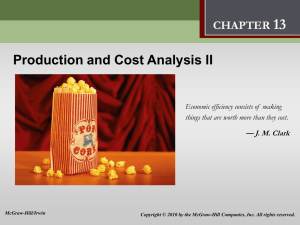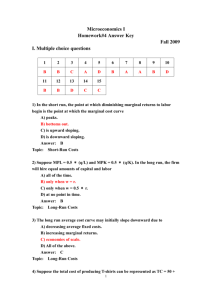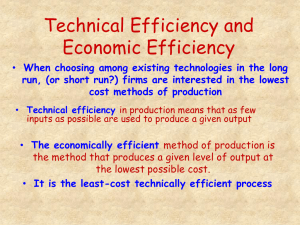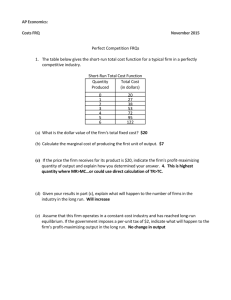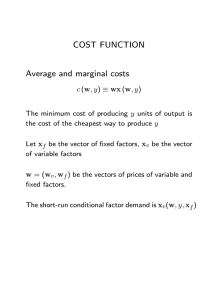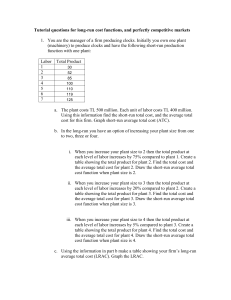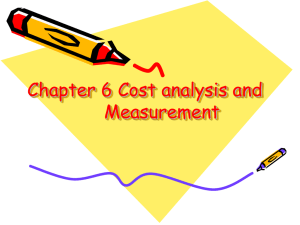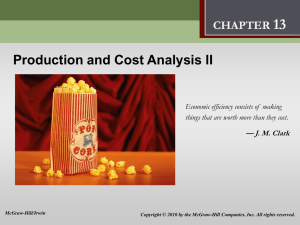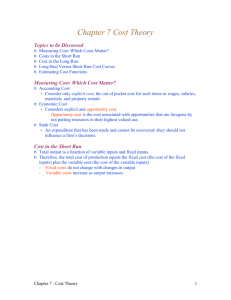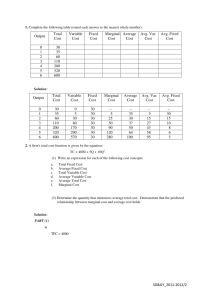File
advertisement
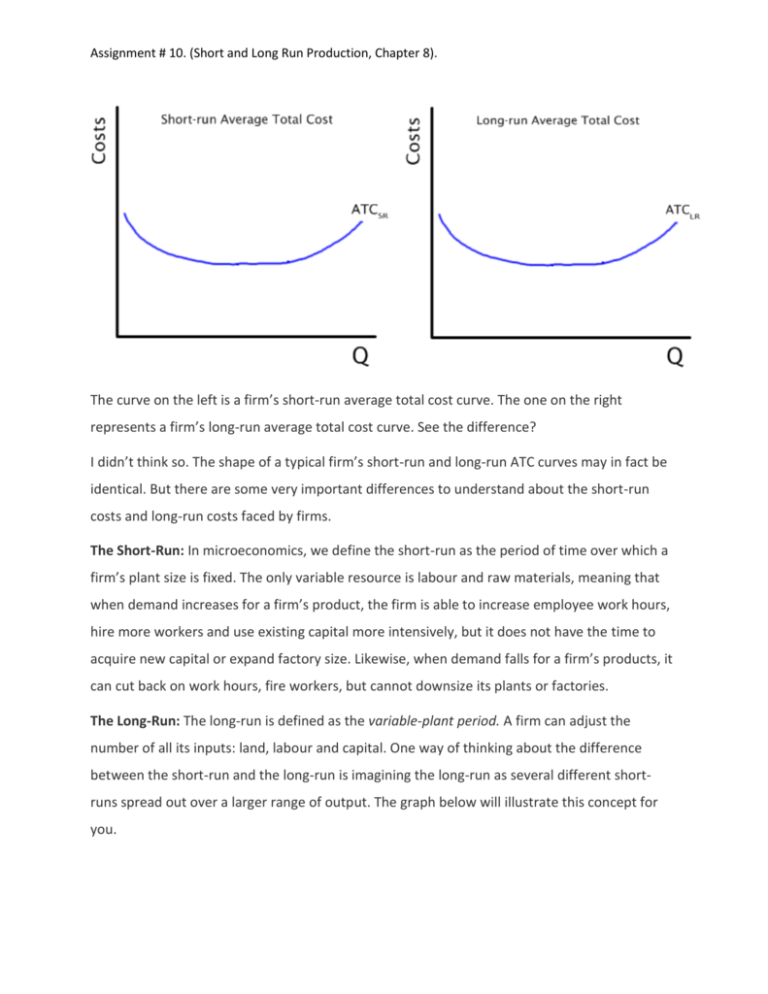
Assignment # 10. (Short and Long Run Production, Chapter 8). The curve on the left is a firm’s short-run average total cost curve. The one on the right represents a firm’s long-run average total cost curve. See the difference? I didn’t think so. The shape of a typical firm’s short-run and long-run ATC curves may in fact be identical. But there are some very important differences to understand about the short-run costs and long-run costs faced by firms. The Short-Run: In microeconomics, we define the short-run as the period of time over which a firm’s plant size is fixed. The only variable resource is labour and raw materials, meaning that when demand increases for a firm’s product, the firm is able to increase employee work hours, hire more workers and use existing capital more intensively, but it does not have the time to acquire new capital or expand factory size. Likewise, when demand falls for a firm’s products, it can cut back on work hours, fire workers, but cannot downsize its plants or factories. The Long-Run: The long-run is defined as the variable-plant period. A firm can adjust the number of all its inputs: land, labour and capital. One way of thinking about the difference between the short-run and the long-run is imagining the long-run as several different shortruns spread out over a larger range of output. The graph below will illustrate this concept for you. Assignment # 10. (Short and Long Run Production, Chapter 8). When we examine the long-run ATC more closely, it becomes apparent that there are in fact lots of little short-run ATC curves along the length of the long-run curve. Each of the gray lines in the graph above represents a short-run period in which this firm opened a new factory. There are three distinct phases of this firm’s long-run ATC: Economies of scale: As this firm first begins to grow and open new factories, it becomes better and better at what it is producing, is able to get more output per unit of input, and thus experiences lower and lower average total costs as it grows larger. “Scale” is a synonym for size. The bigger the firm’s size, the lower its costs of production: this is called “economies of scale”. My favourite illustration of the concept of economies of scale is to think about two shoe companies: Nike and Luigi’s Fine Italian Shoes. Nike makes shoes in giant factories in Indonesia, ships them in giant containers to all corners of the world in shipments containing 100,000 shoes each. Luigi makes shoes in his basement in Milan, has two employees, and ships shoes one at a time to customers around Europe. Who will have a lower average total cost of producing shoes? Luigi or Nike? Clearly, Nike has economies of scale, Luigi does not. If Luigi were to grow his business, chances are his average total costs would decline. Constant Returns to Scale: For the firm above, economies of scale assure that the larger it becomes, the lower its average total costs get. Efficiency in production improves whether Assignment # 10. (Short and Long Run Production, Chapter 8). through the lower price of inputs achieved through bulk-ordering, its ability to attract and hire skilled managers, the lower per unit cost of shipping larger quantities of products, or other such benefits of being big. At a certain point, however, the benefits of getting larger begin to diminish. This firm’s tenth factory is its minimum efficient scale: The level of total output this firm must achieve to minimize its long-run average total cost. Beyond this level of production, as this firm continues to grow, it will see no further cost benefits; in other words, it will achieve constant returns to scale (size). Diseconomies of scale: Why did the Mongol, the British and the Soviet empires collapse? Some historians argue it was because they became too big for their own good. When an organization (whether it’s a country or a firm) becomes TOO big, it begins to experience inefficiencies. When a firm grows so large that it has factories in all corners of the world, a dozen levels of management, and countless opportunities for corruption and miscommunication, its efficiency decreases and its average total costs begin to increase. In the 1980′s General Motor Company began to lose lots of business to smaller Japanese rivals. The outcome was the gigantic corporation broke up into smaller divisions, which then began to operate as different firms. For a while, GM remained competitive, partially because as a smaller firm, it was more efficient and able to compete on cost with its foreign rivals. Diminishing Returns versus Economies of Scale: A common area of confusion for economics students is the difference between these two seemingly similar concepts. The difference lies in the two curves above, the short-run ATC and the long-run ATC. The shape of short run costs (MC, ATC and AVC) are determined by the law of diminishing returns. Since short-run costs are determined by the productivity of the variable resource in the short-run (labour), diminishing returns assures that at first, since a firm can expect to get MORE output for additional units of labour (as fixed capital is used more efficiently) ATC declines as output increases. But beyond a certain point, diminishing returns sets in and the additional output attributable to more units of the variable resource declines. Inevitably, a firm will experience higher and higher average costs as its output continues to grow, since it’s only able to vary the amount of labour used, not capital. Assignment # 10. (Short and Long Run Production, Chapter 8). The shape of long run ATC is determined by economies of scale (and diseconomies of scale). All resources are variable in the long-run, but lower costs cannot be guaranteed the larger a firm gets. At first, efficiency is improved as the firm grows, but at some point it becomes “too big for its own good” and costs start to rise as productivity of resources (land, labour and capital) is inhibited due to the firm’s massive size. Discussion Questions: 1. What does it mean that a firm can become “too big for its own good”? Can you think of any other organizations (economic or otherwise) that have gotten so big that they’ve failed? 2. Why does your hometown have only one electricity company? Why aren’t utility industries such as water, natural gas, and garbage collection more competitive? How does the concept of economies of scale lead to certain industries being “natural monopolies”? 3. Why don’t more companies make jumbo jets?

